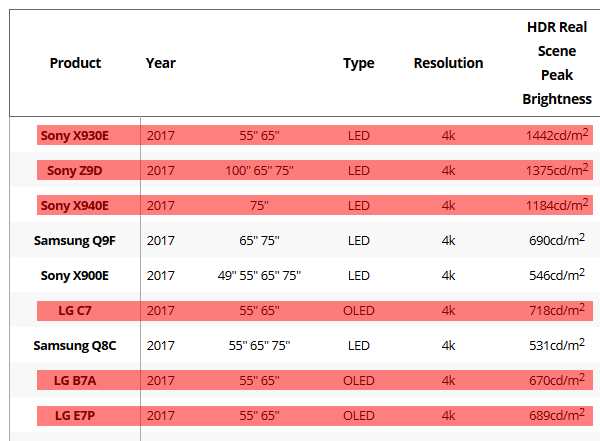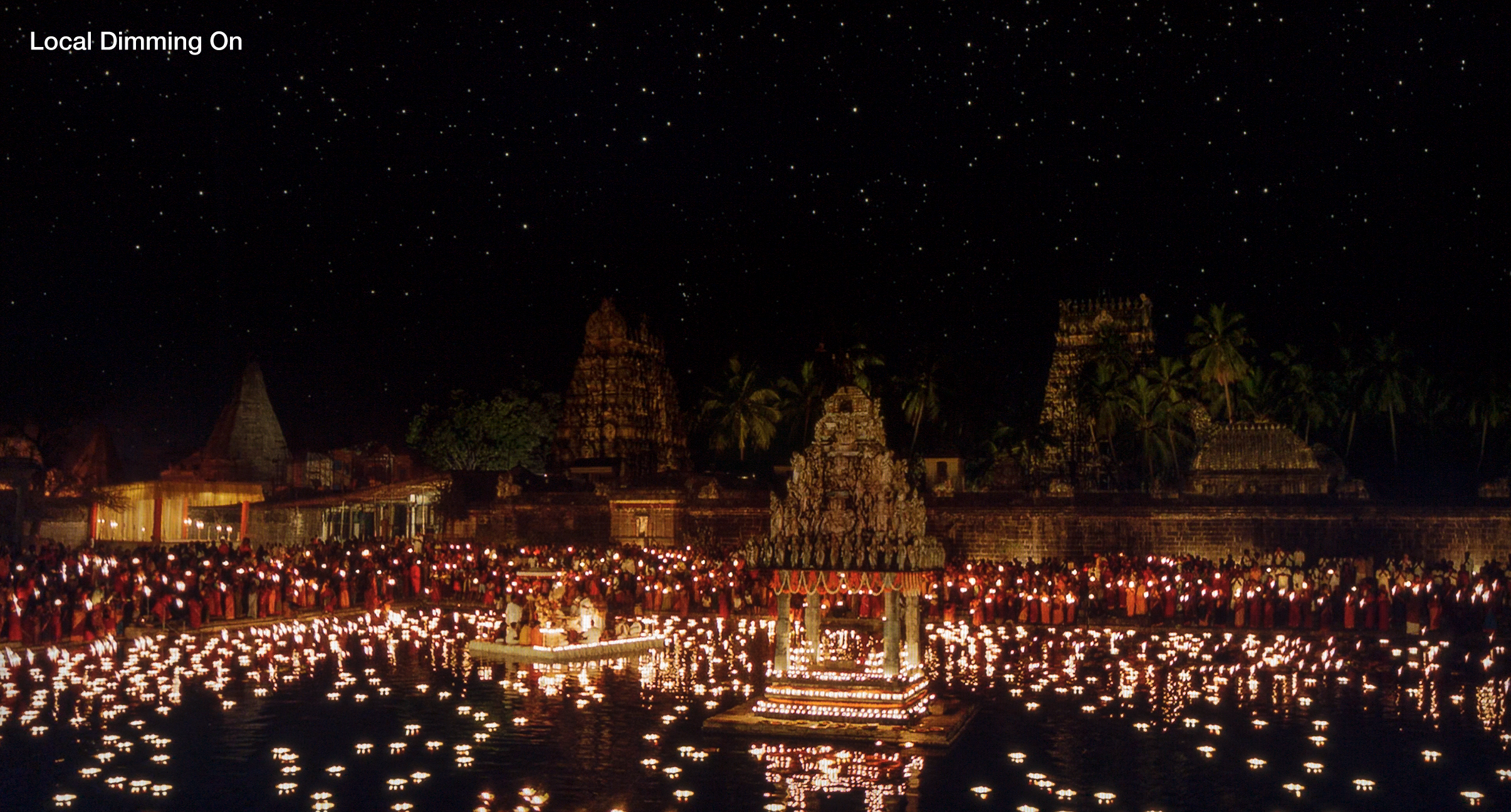Page 4 of 4
Re: Is Local Dimming/Quantum Dots Really a Good Thing?
Posted: 18 Dec 2017, 15:40
by jorimt
BattleAxeVR wrote:I'd much rather own an OLED since I watch in the dark mostly, but if I were buying a daytime TV for the wife n kids, I'd save some cash and get a dirt cheap FALD LCD with Dolby Vision for a fraction of the price and a measurably bigger colour volume which makes HDR pop like crazy.
That said, the newer OLEDs are getting better white levels too. OTOH LCDs get bigger and bigger and cheaper and cheaper every year. We'll see which tech wins out, I hope it's OLED but regardless it's the consumer who wins when there's competition.
That's a deceivingly tricky subject, because while almost any LED will beat an OLED in peak HDR brightness in a full white field test, on the majority of the cheaper FALD or edge-lit local-dimming TVs, the HDR brightness/color volume advantage over OLED can quickly be lost in real-world content.
According to RTING's reviews, only three 2017 LED TVs they've test so far have far surpass the "HDR Real Scene Peak Brightness" of the 2017 LG OLEDs, two of which aren't "dirt cheap:"
 Full comparison list:
https://www.rtings.com/tv/tests/picture ... brightness
Full comparison list:
https://www.rtings.com/tv/tests/picture ... brightness
In fact, many of the cheaper LED TV models, FALD or no, actually have a lower peak HDR brightness (some much lower) in actual content when compared to this year's LG OLEDs.
Re: Is Local Dimming/Quantum Dots Really a Good Thing?
Posted: 18 Dec 2017, 16:30
by sharknice
jorimt wrote:@open, emissive quantum dot tech is likely a long wait yet.
But unfortunately, anything emissive is subject to retention due to uneven aging. This isn't an issue with balanced media viewing (I own an LG C7 OLED solely for movies/TV use, and haven't had a hint of permanent retention issues), but it's definitely something they'll struggle to solve completely for dedicated, UI-heavy gaming monitors (let alone prolonged desktop and web use).
FALDs are also subject to uneven aging.
But even single lightsource LCDs aren't uniformly lit when they're brand new. Emissive pixels are at least uniform when they're new.
I also wonder how bad they actually get when they're older.
Re: Is Local Dimming/Quantum Dots Really a Good Thing?
Posted: 18 Dec 2017, 16:34
by jorimt
@sharknice, correct, that and overall DSE (dirty screen effect); my FALD TV has what looks like a more pronounced version of OLED vertical banding during slow pans and uniform grey screens because of this.
FALD LEDs still do have the retention/burn-in advantage over emissive, nonetheless.
Re: Is Local Dimming/Quantum Dots Really a Good Thing?
Posted: 25 Dec 2017, 02:56
by Glide
People overstate how bad haloing can be on FALD displays because they either haven't seen a good one, or haven't seen one at all.
It's there, no doubt about it, and local dimming kills viewing angles, but over-exposed photographs don't give an accurate representation of local dimming.
Here's a properly exposed image of my old Sony FALD LCD with a 5000:1 native contrast panel and ~100 zones. (I think it's something like 12x8; I haven't checked in some time)

(this is an animated PNG file and not all browsers support them)
Source Frame. Note that some of what you might think is blooming is actually part of the source.
You can see that it's not perfect, but it basically does just make black levels better without any real compromises to image quality.
I specifically chose a scene with stars in the sky and lots of small light sources since people always claim that FALD can't handle that.
They're certainly not perfect, but a good implementation is far better than many people give them credit, and displays with a higher density of zones should greatly improve that.
Unfortunately the panels these days are probably going to be lower contrast; either a 1000:1 IPS or 3000:1 AMVA panel, but it should still be pretty good.
Sure, contrast will not match OLED, but that doesn't mean it's not a significant improvement over a uniform backlight.
sharknice wrote:FALDs are also subject to uneven aging.
That's not been my experience after ~7 years of heavy use.
Re: Is Local Dimming/Quantum Dots Really a Good Thing?
Posted: 25 Dec 2017, 13:19
by darzo
Are those two images with HDR on?
Re: Is Local Dimming/Quantum Dots Really a Good Thing?
Posted: 26 Dec 2017, 13:12
by Glide
darzo wrote:Are those two images with HDR on?
No, it's a 2010 TV so both images are SDR with and without local dimming.
Re: Is Local Dimming/Quantum Dots Really a Good Thing?
Posted: 26 Dec 2017, 13:16
by darzo
So would HDR reduce the difference?
Re: Is Local Dimming/Quantum Dots Really a Good Thing?
Posted: 26 Dec 2017, 13:20
by BattleAxeVR
There's no doubt that FALD is a massive image quality improver for LCD tech, regardless of the underlying native contrast. I remember discussing with someone on AVS about FALD + VA or FALD + IPS and they said IPS' shortfalls in the native CR department are overcome by the huge improvement to overall intra-scene contrast. For a TV meant to be watched by several people in a living room, FALD + IPS is probably a much better choice. For a PC monitor meant for single user sitting in the sweet spot, FALD + VA + Curved FTW. (at least for black levels with minimal haloing due to FALD zones).
Hisense and Vizio make high-zone count HDR FALD TVs that are ridiculously cheap now like 500$ or less. Some even have 120hz at 1080p with low input lag. That's a big win for gaming right there. 1080p120 > 2160p60 in terms of image clarity with any type of movement going on.
Re: Is Local Dimming/Quantum Dots Really a Good Thing?
Posted: 26 Dec 2017, 13:22
by BattleAxeVR
darzo wrote:So would HDR reduce the difference?
HDR makes the benefits of FALD even more pronounced, since HDR TVs have a much brighter backlight requiring even more local dimming to bring the black floor back down, where appropriate.
Recent Sony HDR TVs have local contrast enhancement, which is a huge, huge improvement. They're using it in games now. (local tone mapping = preserves local contrast).
Re: Is Local Dimming/Quantum Dots Really a Good Thing?
Posted: 26 Dec 2017, 13:53
by Glide
BattleAxeVR wrote:There's no doubt that FALD is a massive image quality improver for LCD tech, regardless of the underlying native contrast. I remember discussing with someone on AVS about FALD + VA or FALD + IPS and they said IPS' shortfalls in the native CR department are overcome by the huge improvement to overall intra-scene contrast.
Yes, it benefits any LCD, though the higher the native contrast, the less visible haloing will be.
The implementation - and Sony have a lot of experience in this area - matters a great deal though. Good dimming algorithms can outperform sets which should perform better on-paper due to things like a greater number of zones.
BattleAxeVR wrote:For a TV meant to be watched by several people in a living room, FALD + IPS is probably a much better choice. For a PC monitor meant for single user sitting in the sweet spot, FALD + VA + Curved FTW. (at least for black levels with minimal haloing due to FALD zones).
FALD destroys viewing angles. The brightness/contrast of the dimming zones does not change nearly as much with viewing angle as the LCD panel does. As a result, the underlying grid structure of the FALD system starts to become very obvious.
It's acceptable in a bright room, but in a dark room you don't want to be viewing an FALD display at an angle whether it's IPS, VA, or anything else.
That being said, I greatly prefer IPS LCD displays to VA LCD displays despite the lower native contrast. I hate the contrast/gamma/color shifting the happens on VA panels. Even if you're viewing the sets directly facing the panel, if you sit close the edges will be brighter and a different color than the center of the screen.

